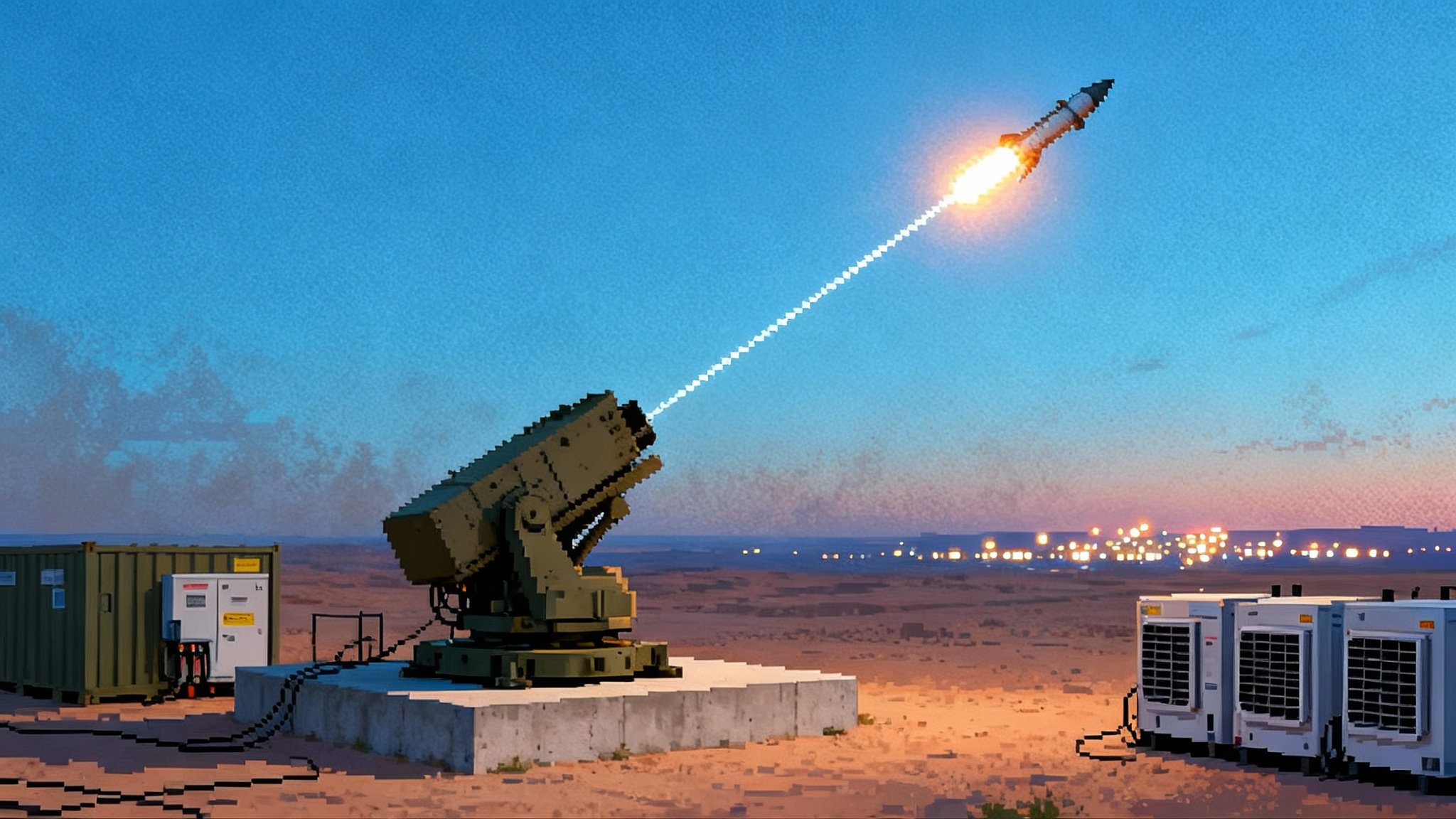Iron Beam Goes Operational, Rewriting Air-Defense Math
Israel says its Iron Beam high‑energy laser has finished testing and will enter IDF service in 2025. Here is how directed energy changes the cost per shot against drones and rockets, where physics still limits performance, and what this milestone means for U.S. and UK programs.

The week lasers left the lab
Israel just crossed a threshold. On September 17 to 18, 2025, the Ministry of Defense and prime contractor Rafael announced that Iron Beam, the country’s high‑energy laser air‑defense system, finished its test campaign and is slated for Israel Defense Forces integration before year’s end. That declaration marked the first time a major military said a high‑power, hard‑kill laser would move from prototypes into real operational service. The news, reported the same day, underlined a simple point that could reshape short‑range air defense economics: photons are cheap compared with missiles. See Reuters coverage of the milestone.
Rafael and Israel’s Directorate of Defense Research and Development have pointed to this moment for years, with 2022 interception videos, accelerated wartime prototyping, and recent statements that a first tranche would be absorbed into the air‑defense network. The Hebrew name Or Eitan, honoring the fallen commando Capt. Eitan Oster, underscores how much national energy has pooled behind the project. For context on how lasers fit with missiles and guns, see our layered air defense strategy.
Why cost per shot is the strategic lever
Modern air defense has a sustainability problem. Adversaries now mass cheap drones, rockets, and improvised loitering munitions, trying to saturate defenses that rely on interceptors costing tens or hundreds of thousands of dollars each. Even when defenders win tactically, the ledger bleeds red.
Lasers attack the math from the other side. A high‑energy laser consumes electricity, not a missile round. The marginal cost per shot is often quoted in single‑digit dollars for electricity and wear items. Even if the true all‑in cost is higher once you account for maintenance, spares, and crew time, it remains orders of magnitude below an interceptor. That creates a new division of labor inside layered air defense. Kinetic rounds stay reserved for high‑end threats or when weather closes the laser window. Lasers take the bulk work against small and medium targets when skies are clear and the power bus is humming.
This matters most in attrition campaigns. If your air‑defense battery can fire hundreds of shots in a day without raiding a missile magazine or a logistics convoy, you have strategic endurance. If your adversary faces a defender whose per‑engagement cost is negligible compared with its drone fleet, the attacker’s saturation calculus changes quickly. For more on tactics against drones, see our counter UAS playbook.
How a laser kill actually works
A high‑energy laser weapon is not a sci‑fi zap. It is a precision heat pump. The fire control system tracks the target, stabilizes the beam director, focuses a coherent beam onto a small spot, and holds that spot long enough to dump lethal energy into a vulnerable area. On drones and rockets that typically means burning through a skin panel to ignite internal components, cooking sensors, or cutting a control surface so the target tumbles and breaks up.
Key pieces must work together flawlessly:
- Sensing and tracking. Electro‑optical and infrared sensors, sometimes cued by radar, must keep a steady track with arcsecond‑level precision. The better the track, the tighter the spot, the shorter the dwell time.
- Beam control. Adaptive optics and fine steering mirrors compensate for platform jitter and some atmospheric turbulence. Without this, much of the laser’s energy smears into the air.
- Power and thermal. The weapon must source high electrical power for the laser and then remove comparable waste heat. That means generators, power conditioning, and large heatsinks or liquid cooling loops.
- Engagement management. Software decides which targets to burn first, how long, and whether to re‑engage, all while keeping the power and thermal budget within safe limits.
Iron Beam is widely described as a 100‑plus kilowatt class system. At that level, it can defeat common rockets, mortars, and Group 1 to Group 3 drones at several kilometers. Dwell time tends to be measured in seconds. That makes multi‑target management a real software and power‑budget problem. The payoff is that a well‑tuned system can work through a small barrage, shot to shot, with inorganic patience and no reload breaks. For a technical overview, see our directed energy primer.
The hard limits that still bite
Lasers are not magic. Their physics comes with constraints that an adversary can exploit and planners must respect.
- Weather and obscurants. Fog, low clouds, rain, and heavy aerosols scatter or absorb energy, which stretches dwell times and shrinks effective range. Dust and battlefield smoke can be nearly as bad as rain. In marginal conditions, lasers still work at shorter ranges, but the engagement envelope collapses. This is why Israel and other adopters are clear that lasers complement, not replace, interceptors.
- Power generation and thermal management. A 100 kW laser consumes far more than 100 kW at the wall plug. The waste heat rivaling a small industrial plant has to go somewhere. Ground systems can tow generators and chillers. Ship systems can tap ship power and seawater cooling, which is a major reason navies are keen on lasers. On vehicles, designers juggle payload, power, and cooling under tight size and weight limits.
- Beam control in turbulence. Close to the ground on hot days, air shimmers with turbulence that distorts wavefronts. Adaptive optics helps, but a hot boundary layer can still knock energy out of the spot. Engagement geometry matters too. Shots through long near‑horizontal air paths suffer more than shots into clear, thin air.
- Dwell time and saturation. Lasers work by depositing energy over time. Against a single small drone, that time is short. Against a salvo, the queue adds up. If a dozen rockets arrive at once, the laser must sequence or share its beam between targets. That forces tradeoffs between burn depth and breadth, and it is where layered defenses still need missiles and guns.
A layered future, not a single silver bullet
Israel is integrating Iron Beam alongside Iron Dome, David’s Sling, and Arrow. The concept is straightforward. Lasers swat the cheapest, most numerous threats when weather cooperates. Interceptors handle the rest and act as the all‑weather backstop. Over time, as higher power modules mature and better beam control trims dwell times, the laser’s share of the work will grow.
Expect doctrine and training to evolve quickly. Operators will learn when to hold fire so the beam is fresh for a denser burst twenty seconds later, when to accept a partial burn and let blast overpressure finish the job, and when to pass a track to a missile battery. The fire control software will learn those habits too.
What this means for allied programs
- U.S. Army DE M‑SHORAD. The Army has fielded 50 kW class Stryker‑mounted laser prototypes to develop tactics against drones and to build maintenance muscle memory. Those units have trained and assessed the systems in diverse conditions. Iron Beam’s transition will validate the Army’s push to move lasers from demonstrations to dirt, and it will provide early operational data for how to schedule power, cooling, and crew workflows over long surges.
- U.S. Army IFPC‑HEL. The 300 kW class Indirect Fire Protection Capability laser remains the big bet for defending fixed and semi‑fixed sites against rockets and cruise‑like targets. If Iron Beam shows reliable, low‑cost knockdown of short‑range rockets and mortars, it strengthens the case that higher power lasers can shoulder more of the base‑defense mission. It also underscores the importance of all‑weather pairing with interceptors and high‑powered microwave systems for drone swarms.
- U.S. Navy HELIOS and successors. The Navy’s calculus is especially favorable at sea. Ships have megawatts of power and plenty of cooling, and they need magazines that do not run dry in a long escort mission. A mature laser gives destroyers a cheap way to defeat drones and small boats while saving expensive missiles for high‑end threats. Iron Beam’s fielding increases pressure to push ship lasers from limited deployments toward fleet‑wide utility before the decade ends.
- UK DragonFire. The United Kingdom has pulled its naval laser schedule forward, with plans to put DragonFire on Royal Navy ships starting in 2027. The Ministry of Defence has highlighted accuracy and a per‑shot cost around ten pounds. See the UK MoD announcement on DragonFire.
Naval and mobile variants through 2030
- Israel’s naval Iron Beam. A shipboard variant is a natural next step. On corvettes and larger hulls, a maritime version would benefit from stable platforms, steady power, and seawater cooling. The mission would mirror land jobs, mainly counter UAS and short‑range rocket or drone boat threats, with the bonus of using the ship as a mobile air‑defense node for a port or task group.
- Mobile Iron Beam. Trucked and trailer versions open the door to convoy and point defense. The constraints are familiar, power and cooling, but Iron Beam’s architecture appears modular enough to scale. By 2030, expect at least one export customer to pursue a mobile variant for base defense and critical infrastructure.
- U.S. fleets. At sea, ship lasers should progress from 60 kW class prototypes toward higher power levels late in the decade, with improved beam control and ruggedized optical benches. On land, the Army’s IFPC‑HEL sites will pursue 24/7 duty cycles with hybrid power, smart thermal stores, and integration with hard‑kill interceptors and non‑kinetic systems like high‑power microwave.
- UK forces. DragonFire’s early shipboard integration from 2027 will drive fast lessons in targeting software, safety envelopes on crowded decks, and rules of engagement near commercial traffic. An army variant later in the decade would give the UK a portable defense for airfields, ammunition depots, and deployed brigade hubs.
Likely countermeasures and the cat and mouse game
No new defense arrives without an offense ready to adapt. Expect these countermeasures and tactics.
- Weather exploitation. Adversaries will shoot and fly under low clouds, through fog banks, and during dust events. They will pop smoke or aerosol screens near launch points and along ingress routes.
- Salvo timing. Shorter, denser barrages stress dwell‑time queues and force the defender to triage. Swarms that mix small drones with a few larger or hardened vehicles aim to soak laser time, then slip a high‑value round through.
- Hardening and shaping. Reflective paints offer little help because they heat and char, but thin ablative coatings, shiny inner bays, and heat‑resistant skins can buy seconds. Tumbling or spinning projectiles force the beam to chase a moving point on the airframe. Designers may route critical lines behind structural ribs, place battery packs away from vents, or add sacrificial shrouds.
- Tactics against sensors. Lasers need exquisite tracking. Attackers will jam or dazzle electro‑optical sensors, scatter decoy glints, fly low against clutter, or approach from sun angles that complicate tracking.
- Decoys and false targets. Cheap foam gliders with IR strobes or octocopters carrying corner reflectors can dilute a defender’s attention and waste laser time.
The answer will be better cueing, smarter target classification, and multi‑sensor fusion. Expect defenders to pair lasers with radar, electronic warfare, and kinetic effectors in a common fire control, and to add predictive engagement logic that prioritizes the targets most likely to cause harm with the least burn time.
Exports, partnerships, and politics
Iron Beam will be one of the most sought after systems in the export market, but the path is not simple.
- Demand drivers. Any country facing rocket or drone harassment, especially around critical infrastructure, will be interested. Gulf states, Eastern European front‑line countries, and Pacific partners with base‑defense needs top the list.
- Industrial teaming. Rafael’s cooperation with U.S. firms could evolve into production partnerships to meet demand and manage technology transfer risk. Buyers may see versions tailored to local power standards and existing command and control systems.
- Policy constraints. Israel has historically been selective about sensitive exports. Add U.S. International Traffic in Arms Regulations where American subsystems are involved, and the pipeline will be political as much as technical. Early foreign operators are likely to be close security partners with well established end‑use monitoring.
- Competitive landscape. The U.S. Army’s IFPC‑HEL and Navy lasers, if they prove reliable, will produce American export options by late decade. The UK’s DragonFire could offer a European path. Several countries are also maturing smaller counter UAS lasers. Buyers will weigh openness, cost, and how quickly a vendor can move from demo to delivered systems.
What to watch from now to 2030
- Weather performance data. The first full seasons of Iron Beam operation will show exactly how often lasers can carry the load in real weather. Those numbers will drive budgets far more than any brochure.
- Power and cooling innovations. Hybrid gensets, battery buffers, and phase‑change thermal stores could unlock longer duty cycles. Naval variants will explore how to ride ship power transients without losing track.
- Smarter beam control. Improvements in adaptive optics and target aimpoint selection will shave dwell times, which is the closest thing lasers have to magazine depth.
- Multi‑weapon fire control. Expect command software that can task a laser, a high‑power microwave, and a missile battery as one organism, scheduling energy and shots the way a good quarterback manages downs.
- Hardening of threats. As attackers toughen drones and rockets, watch for lasers stepping up in power and for mixed‑mode shots that start with a brief microwave pulse to disable electronics, then finish with a short burn.
- Shipboard milestones. The UK’s first DragonFire installation by 2027 and the U.S. Navy’s next increments will signal how quickly navies can turn lasers from science projects into fleet tools.
The bottom line
Iron Beam’s transition into service is not the end of interceptors, it is the beginning of affordable air‑defense volume. Physics still imposes limits, especially when the air is full of water or dust. But on clear days and cold nights, lasers are about to chew through the cheap end of the threat spectrum at a price per shot that favors the defender. If Israel proves the concept at scale through 2026, allied programs will accelerate, naval variants will proliferate, and by 2030 layered defenses will look different. The calculus will center on power management, weather windows, and software that treats energy as ammunition. That is a different game, and it is one defenders have waited years to play.








